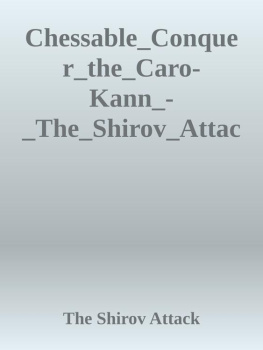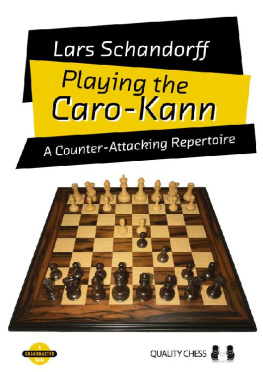Erwin LAmi - chessable Lifetime Repertoires: Caro-Kann
Here you can read online Erwin LAmi - chessable Lifetime Repertoires: Caro-Kann full text of the book (entire story) in english for free. Download pdf and epub, get meaning, cover and reviews about this ebook. genre: Home and family. Description of the work, (preface) as well as reviews are available. Best literature library LitArk.com created for fans of good reading and offers a wide selection of genres:
Romance novel
Science fiction
Adventure
Detective
Science
History
Home and family
Prose
Art
Politics
Computer
Non-fiction
Religion
Business
Children
Humor
Choose a favorite category and find really read worthwhile books. Enjoy immersion in the world of imagination, feel the emotions of the characters or learn something new for yourself, make an fascinating discovery.

- Book:chessable Lifetime Repertoires: Caro-Kann
- Author:
- Genre:
- Rating:4 / 5
- Favourites:Add to favourites
- Your mark:
- 80
- 1
- 2
- 3
- 4
- 5
chessable Lifetime Repertoires: Caro-Kann: summary, description and annotation
We offer to read an annotation, description, summary or preface (depends on what the author of the book "chessable Lifetime Repertoires: Caro-Kann" wrote himself). If you haven't found the necessary information about the book — write in the comments, we will try to find it.
chessable Lifetime Repertoires: Caro-Kann — read online for free the complete book (whole text) full work
Below is the text of the book, divided by pages. System saving the place of the last page read, allows you to conveniently read the book "chessable Lifetime Repertoires: Caro-Kann" online for free, without having to search again every time where you left off. Put a bookmark, and you can go to the page where you finished reading at any time.
Font size:
Interval:
Bookmark:
[Event ?]
[Site ?]
[Date ????.??.??]
[Round ?]
[White Introduction]
[Black Introduction]
[Result *]
1. e4 c6
{ Caro-Kann: A Lifetime Repertoire It is with great joy that I introduce the reader to the Caro-Kann Defence. World Champions like Anatoly Karpov and Mikhail Botvinnik played the Caro throughout their entire career, which should serve as a stamp of approval to make it our Lifetime Repertoire. I, Erwin lAmi from the Netherlands, have been a grandmaster since 2005 and a professional chess player ever since. My most notable tournament victory was the 2015 edition of the Reykjavik Open and, dating back to 2006, I have been a member of the Dutch Olympiad team. But I am perhaps better known for my work as a second. A second helps another player come to the game as best prepared as possible. That means opening work, and a lot of it! For about three years I was part of Veselin Topalovs team and the memories around Topalovs 2010 World Championship match against Vishy Anand I still cherish to this day despite the result! These days, I regularly help Anish Giri who is arguably the best prepared player in the world. Without doubt, the work for this course greatly corresponds with the work I have been doing as a second. Engines Engines changed the world of chess and I will bypass the discussion whether they did in a good or bad way (bad, obviously) . As an ambitious 17 y.o. International Master I bought my first computer, at the time - state of the art. It had four whooping processors and I was proudly running the program Junior 6, which was hugely aggressive and would suggest the most ludicrous sacrifices. Developments have been rapid since those days and my phone would now defeat my sophisticated computer with disappointing ease. Just two years ago, the latest engine revolution hit the chess world when Google introduced its AlphaZero (A0) , which demolished the top program Stockfish 8 with considerable ease. A0 uses a neural network to play the game of chess which was a novelty in the world of chess engines. An open source project, based on Googles technique, started soon after and nowadays Leela Zero (Lc0) can be used by any chess fan across the globe. The difference with Lc0 and Stockfish is that the former has incredible instincts, while the later calculates incredibly well. When using these two engines in the preparation of this course, Lc0 pointed out a multitude of new directions. The combination is the perfect analysis tool. The process Given the special times we live in I - like the majority of worlds population - spent most of my days indoors for the past few months. That gave me the opportunity to submerge myself into this project like I have never done before. I have quite literally woken up and fallen asleep with this course in mind. At times I thought the finishing line would never be in sight! You can be certain: the responsibility of handling a repertoire that lasts a lifetime is one I take very seriously! This is also a good moment to thank my wife Alina for the enormous contributions she has made in the creation of this course. Quick Pointers The course obviously covers the entire Caro-Kann, meaning all of Whites possibilities after 1.e4 c6. In two cases I have decided to give an alternative as well. Since this is a Lifetime Repertoire I think its a good idea to be able to switch things around. Thats why in the Advance Variation: @@StartFEN@@rnbqkbnr/pppppppp/8/8/8/8/PPPPPPPP/RNBQKBNR w KQkq - 0 1@@EndFEN@@ 1.e4 c6 2.d4 d5 3.e5 I have covered the conventional 3Bf5 , as well as the alternative 3c5 (Chapters1 -3.) The same applies to the Classical Variation: 1.e4 c6 2.d4 d5 3.Nc3 dxe4 4.Nxe4 where I, perhaps somewhat surprisingly to seasoned Caro-Kann players, have chosen 4Nf6 as the main recommendation. At the same time, I covered themore popular 4Bf5 as well and I leave it to the reader to decide which of the systems appeals more. I would recommend going through all the material before making that decision. Under the guidance of Lc0, the move4Nf6 in the Classical Variation has truly undergone a metamorphosis! Everything related to the Classical Variation is covered in Chapters 4-8 and all other variations have gotten just one recommendation as they are not nearly as critical. I have tried to illustrate why I came to certain choices throughout the course and hope that I have been able to get those points across. Given the abundance of trainable lines, I have tried to limit the number of trainable moves, often cutting the line towards the end. That way I feel the course remains within acceptable boundaries. When going through the moves a bunch of arrows, circles and whatnot will appear on the board. I trust it will be easier when you just see it. A little guideline regarding the colours: yellow - indicates an idea for White red - points at something bad green - is used for Blacks plans. Discussions & Updates Finally, I am very curious what you think of the course. I hope we will have a lively Discussion Forum and I am always ready to answer any questions you may have. It is my intention to regularly update the course since opening theory has this annoying tendency to always move forward! Now without further ado, I would invite you to the Quickstarter Guide in order to get a peek into what we will be doing in this course. }
*
[Event ?]
[Site ?]
[Date ????.??.??]
[Round ?]
[White Quickstarter Guide]
[Black Advance Variation 3Bf5 4.Nf3 #1]
[Result *]
1. e4 c6
{ This course will be a full repertoire against 1.e4, based on the Caro-Kann. In this Quickstarter Guide I will give a rough overview of what you can expect but obviously I would refer you to the corresponding chapters for a (much) more detailed coverage. The Quickstarter Guide is created to show the framework of the entire repertoire. }
2. d4 { The most logical reply. White takes hold of the centre. } 2 d5 3. e5
{ The Advance Variation is currently considered the big test against the Caro-Kann. White simply grabs space. }
3 Bf5
{ One of two moves I have covered in this course. Before playing e7-e6, Black first gets his bishop out. The more direct 3c5 is the alternative. }
4. Nf3
{ White has many options onmove 4 and we will cover them all in the course. }
4 e6 5. Be2
{ TheShort Variation is considered the main line, where White is naturally developing his pieces. }
5 c5
{ The most reliable move. Black wants to play Nc6 next to challenge the centre. }
6. Be3 Qb6 7. Nc3 Nc6
{ All according to plan. Note that 7Qxb2 8.Qb1 Qxb1+ 9.Rxb1 c4 10.Rxb7 Nc6 11.Nb5 is known to be dangerous for Black. }
8. Na4
{ Used byAnish Giri to defeat David Navara in the Gashimov Memorial of 2018. }
8 Qa5+ 9. c3 c4
{ I like this move a lot. Navara took on d4, which may be possible too, but the text move requires much less homework. }
10. b4 Qd8 11. O-O h6
{ In the French (and there is a French pawn structure on the board right now) , Black usually has to work very hard to get the c8-bishop into the game. Here its already on f5 ! }
*
[Event ?]
[Site ?]
[Date ????.??.??]
[Round ?]
[White Quickstarter Guide]
[Black Advance Variation 3Bf5 4.Nf3 #2]
[Result *]
1. e4 c6
{ This course will be a full repertoire against 1.e4, based on the Caro-Kann. In this Quickstarter Guide I will give a rough overview of what you can expect but obviously I would refer you to the corresponding chapters for a (much) more detailed coverage. The Quickstarter Guide is created to show the framework of the entire repertoire. }
2. d4 { The most logical reply. White takes hold of the centre. } 2 d5 3. e5
{ The Advance Variation is currently considered the big test against the Caro-Kann. White simply grabs space. }
3 Bf5
{ One of two moves I have covered in this course. Before playing e7-e6, Black first gets his bishop out. The more direct 3c5 is the alternative. }
Next pageFont size:
Interval:
Bookmark:
Similar books «chessable Lifetime Repertoires: Caro-Kann»
Look at similar books to chessable Lifetime Repertoires: Caro-Kann. We have selected literature similar in name and meaning in the hope of providing readers with more options to find new, interesting, not yet read works.
Discussion, reviews of the book chessable Lifetime Repertoires: Caro-Kann and just readers' own opinions. Leave your comments, write what you think about the work, its meaning or the main characters. Specify what exactly you liked and what you didn't like, and why you think so.


